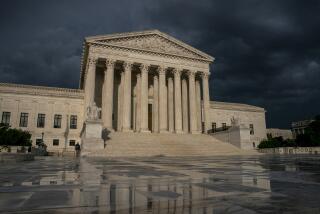Unusual Court Judges History With Twinkle in the Eye
- Share via
SAN FRANCISCO — The past gets a second chance in an unusual court where the cases are supposed to be historical, but often wind up simply hysterical--the Court of Historical Review and Appeals.
There is little resemblance to epic courtroom battles such as those that made Perry Mason famous. Instead the court, founded in 1975, has debated such issues as who invented the doughnut hole, where the martini was first blended and whether the Grinch really stole Christmas.
More serious subjects are also considered, including whether Bruno Hauptmann was guilty in the kidnaping of the son of aviator Charles Lindbergh and whether the court-martial of Brig. Gen. William (Billy) Mitchell reached the right verdict.
Most matters before the court are of less serious import. And from a legal standpoint, laughs are about all the court is good for. It has a judge, lawyers, a courtroom and other judicial trimmings, but no legal power.
Puns flow and participants frequently wear costumes that fit the subject under discussion. All of this in an atmosphere of mirth, in contrast to most courtrooms where such behavior would jump-start a snoozing bailiff and summon a storm of judicial gavel-pounding.
Take the last session, which put the Grinch on the stand. Robert Curl, the court clerk, painted his face and donned a Grinch outfit.
“I only removed all the store-boughten stuff, so people could see that love was enough,” he said in a rhyming defense that would have made Dr. Seuss proud. It was good enough to get him off.
An actor dressed as a chicken showed up when the court debated whether chicken soup was truly “Jewish penicillin.” The “chicken” begged the court to eat vegetables, not poultry. The court decided chicken soup is “very good for you,” while conceding it was “bad for the chicken.”
The court was the brainchild of the late Bernard Averbuch, a public relations executive.
In 1975 he was approached by a local historian who wanted to publicize a police museum. Averbuch got the bright idea of holding court to decide if San Francisco Police Chief George Wittman got a fair deal when he was fired in 1904 for incompetence.
The court concluded that it was a bum rap.
“The Wittman case was a big hit,” said Carolyn Diamond of the Greater Market Street Development Assn., who has taken charge of the court. Now, it hears about 10 cases every year--a total of 69, so far.
“The first ones concerned San Francisco, but then Bernie decided to branch out and do cases of national interest,” said Diamond.
The court is the first of its kind as far as Diamond knows, at least when it comes to holding regular sessions.
If you’re thinking of starting one, think again.
“It’s a lot of work and everyone--judge, lawyers, all of them--volunteer,” said Diamond, who has spent many of her own weekends researching a subject.
Most of the decisions are for laughs, but not all.
There were few dry eyes when the case before the court was whether Hauptmann was guilty of murdering the Lindbergh baby, the crime for which he was executed in 1936.
No costumes were needed. Hauptmann’s 88-year-old widow, Anna, showed up and pleaded with the court to proclaim her husband’s innocence. The appearance marked the first time in 50 years she had been able to argue before a court of any kind.
The court could not overturn the verdict, so it recommended that a body along the lines of the Warren Commission should look at the facts.
It didn’t overturn the verdict against Mitchell, either.
Mitchell faced a court-martial in 1926 for speaking out against military higher-ups for ignoring air power. The court didn’t rule for Mitchell, but decided history had clearly vindicated him.
And what about those doughnut holes?
Municipal Judge George Choppelas dismissed conflicting opinions that the hole may have been the work of a Dutch sea captain, a nearsighted Chinese baker 4,600 years ago or an Italian cook who took his eyes off the pasta.
“Mankind, in its own wisdom, invented the hole in the doughnut,” was the best he could say.
More to Read
Sign up for Essential California
The most important California stories and recommendations in your inbox every morning.
You may occasionally receive promotional content from the Los Angeles Times.













